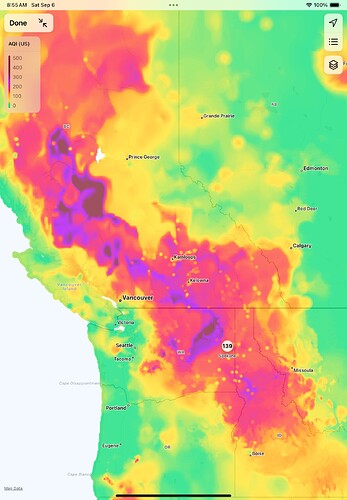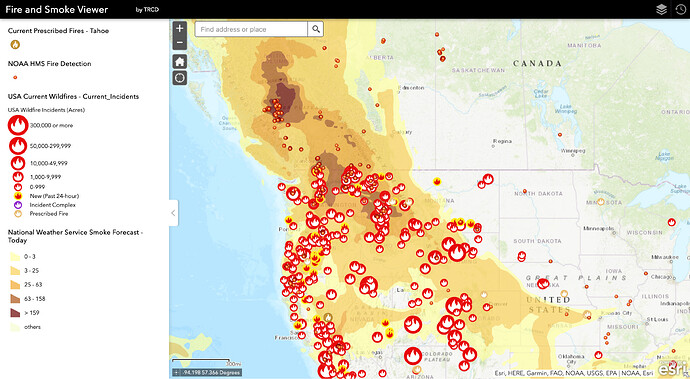I found a couple threads on this but they were an all a few years old so I thought I’d start a new one. The PNW in the US and Canada is currently enveloped in smoke unfortunately so I’m now checking the AQI before heading out for a ride each morning. Over 100 and I’m considering staying inside unless I really ‘need’ to ride outside and if I am outside it’s only Z2. Over 150 is a definitely inside training only.
For me it’s 100, anything above that and I’m usually left with an annoying cough afterwards. That threshold can change depending on whether or not it’s trending up or down, and the duration and intensity of the workout, but that’s my general cutoff to move my workouts indoors.
Timely question for me. Here in CO we often get a higher AQI due to ozone. It doesn’t seem to bother me but I still try to avoid 100+ by going earlier in the day. Right now we have smoke with a fine particle AQI of 79. I can see and smell it. I rode yesterday at a similar fine particle AQI and was coughing the rest of the day and evening, so I’m not riding today. Def NG doing heavy breathing in this stuff. I’m looking for particulate AQI to be better than 50.
Smell test really.
If I cancelled due to AQI, I would be driving to work most days let alone doing any other riding.
The trainer is meant for last resort only.
Smoke particles, PM5 and especially PM2.5, are my main concern. Those get in not only your lungs but even in your blood! I definitely get a cough and sore throat riding intensely in that. So AQI alone isn’t enough, Look at the breakdown.
Where do you live that the AQI is typically over 100?
Agreed, that is typically the bigger concern. Where I live there is correlation between the two is pretty close. ie when the AQI is poor it’s due to wildfires and an elevated Pm2.5
So we at an AQI of 131 today and here is the breakdown
Not the person you’re asking but AQI over 100 is fairly typical for me in western Wyoming between July and September, sometimes well into October; that’s just the reality of living in western North America:
This summer has been surprisingly good, we only started getting 100+ AQI here a couple weeks ago, but there have been summers where I could count the number of days with good air quality with one hand. Some years are even worse; last year a wildfire broke out nearby and the AQI was off the scale for most of September and October.
My outdoor riding season is depressingly short most years, so I tend to do most of my riding and running indoors. You’d be surprised by how much of a difference a good air purifier can make—I have indoor and outdoor PurpleAir sensors in my home and last night when I was working out the AQI was 180+ outside but ~30 in the room where I have my trainer with the air purifier at full blast, even with the windows open.
Anything Smokey and I just don’t bother.
I am lucky that the vast majority of my riding season has very good air quality so doing a few days of indoor riding when it is bad out is not a big issue.
I’m either more sensitive and/or pickier than most.
For a shorter, low intensity ride, I’ll ride outside if PM2.5 isn’t higher than about 80.
For anything with intensity or longer rides, my upper limit is about 60.
I’ve spent most of my life in western Montana, Northern Idaho, or Eastern Washington so I hear you about the bummer end of summer forest fires. But we still don’t have that many days over 100 at least looking at the historical data that is available (assuming I am reading it correctly): World Air Quality Historical Database
Unfortunately there’s no data for Jackson, WY there, but that page shows daily averages, which doesn’t reflect how the AQI can fluctuate during the day. I take your point, though, I don’t have any hard data other than my own recollection of years past being particularly bad.
What apps/sources are you guys using for AQI info? I use the EPA AirNow app.
AQI is solely about predicting your risk of acute mucous membrane irritation when outside.
For me, when ozone levels are up, I get sneezy and congested regardless of whether I’m inside or outside; but would be likely to avoid long rides outside as I hate blowing snot rockets every 30 seconds.
I get no problems at all from PM2.5, so don’t pay attention to it when making riding decisions.
There are different risks to long term daily exposures to elevated PM2.5 levels. Current literature suggests you need daily exposure to an AQI level over about 50 for about ten years straight before it starts to increase your risk of cancer or cardiovascular disease.
Going outside and riding your bike for 4 hours on a day with an AQI of 200 is about as unhealthy for you overall as eating a hotdog, or two pieces of bacon. (Like literally).
If it irritates you then avoid going outside those days. If not… it’s a pretty minor risk to your health in the grand scheme of things.
TLDR: it takes many years of consistent daily exposure to bad air quality levels to develop serious health problems from it. The absolute risk of going out in bad air occasionally is trivial. AQI readings are only about predicting acute mucous membrane irritation. If you’re outside and feel fine, it’s not really a problem.
That’s true, but maybe cigarettes illustrate the risk better than hot dogs or bacon—riding outside for four hours with an AQI of 200 is roughly equivalent to smoking one cigarette:
- An AQI of 200 equals a PM2.5 concentration of 125.4 μg/m³ (source)
- One cigarette per day is roughly equivalent to an exposure to a PM2.5 concentration of 22 μg/m³ (source)
- (125.4 μg/m³ / 22 μg/m³) = 5.7 cigarettes × (4 / 24) = 0.95 cigarettes
One cigarette won’t kill you… but I still don’t want to smoke any cigarettes if I can help it.
I chose that on purpose people lay people tend to significantly overestimate the health risks of smoking a cigarette.
Eating two pieces of bacon is actually less healthy for you than smoking a cigarette or two.
It takes about ten years of smoking 10 cigarettes a day to start to increase your risk of cancer or lung disease even a small amount.
The big problem is that smoking is extremely addictive - the rare person who can truly smoke only 5 cigarettes a day for years on end is extremely unlikely to suffer any adverse health effects from it.
Breathing wildfire smoke is thankfully not addictive that I’m aware of. ![]()
IDK, but I kinda think heavy deep breathing when doing aerobic exercise (riding/running…) pulls much more particulates deeper into the lungs than just being outside or walking around.
As a thought experiment using big round numbers, say I burn 2000 Cal/day with no riding. I’ll respire a total volume of air needed to generate that. Now I do a fast 3hr ride that burns 2000 Cal. In those three hours, I’ll breath the same amount of air that I breath for an entire day, so for that day, double the amount of air (and particulates). Then, of course, during the ride, I’ll be breathing very heavily and deeply. So, is a 2000 cal day with and additional 2000 cal of aerobic exercise equate to two days of normal exposure, one day exposure to double the AQI, or something else/worse?
It does.
Again though, outside of acute mucous membrane irritation, it takes about a decade of daily exposure to markedly elevated PM2.5 levels to start increase your risk of disease.
The dose you receive you receive during a 4h bike in bad air quality conditions is multiple orders of magnitude lower than this.
If you don’t want to bike outside when air quality is bad, I support your decision completely.
But people should also be aware that the absolute value of the health risk associated with doing this, even multiple times a year, is trivial to non-existent.
Again, to put things into perspective, the average person is getting more harm from eating a single hotdog, or even drinking a beer or two, than they are from exercising outside on a day with an AQI in the 100-200 range.
The situation where AQI is a bigger public health problem is in cities where due to pollution, values are always in the 100 range every day, forever.
Where do you get data showing it to be low risk? You can’t take conclusions from the studies you mentioned and apply them to cyclists. Cyclists are breathing a lot more air. The particulate matter embeds in your tissues and we don’t have a good way of removing it. Don’t follow this person’s advice people, unless you want to compromise your performance compared to your competitors, or want to develop asthma.



